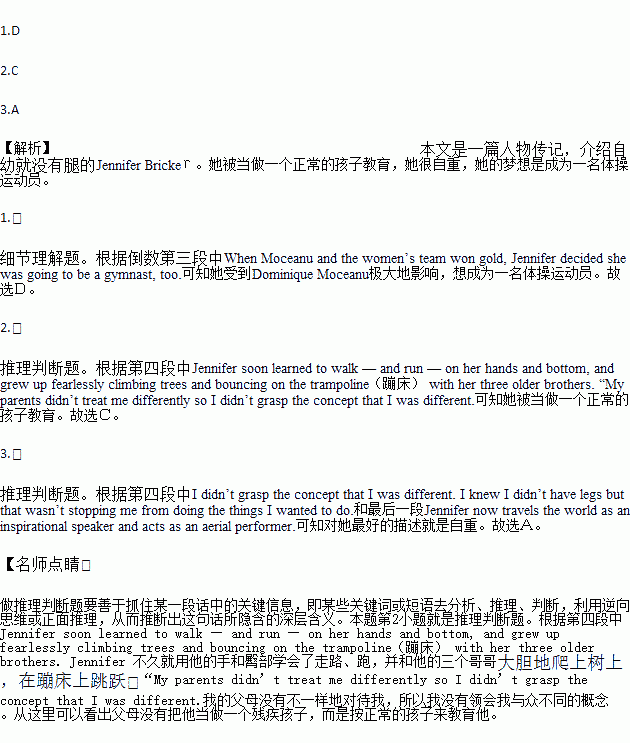题目内容
Aerial performer Jennifer Bricker was born without legs, but she never let it stop her.
Wrapped in a loop of red silk hung from the ceiling Jennifer Bricker climbs and twists to the music. Her head hangs down and her strong arms let go as she balances on her back, high above the ground a move that’s all the more daring because she has no legs.
Jennifer was a few months old when she was adopted by Sharon and Gerald Bricker. She had big brown eyes, a bright smile, and huge amounts of energy. When a doctor advised her adoptive parents to carry her around in a kind of bucket, they refused.
Jennifer soon learned to walk — and run — on her hands and bottom, and grew up fearlessly climbing trees and bouncing on the trampoline(蹦床) with her three older brothers. “My parents didn’t treat me differently so I didn’t grasp the concept that I was different. I knew I didn’t have legs but that wasn’t stopping me from doing the things I wanted to do.”
At the age of three she was fitted with artificial legs, but she never really took to them — she moved more freely without.
In 1996 the Olympic Games took place in Atlanta. Jennifer loved to watch the women’s gymnastics team, and especially adored the 14-year-old Dominique Moceanu who competed for the US. When Moceanu and the women’s team won gold, Jennifer decided she was going to be a gymnast, too. She took up power tumbling, which involves performing floor exercises down a runway. But Jennifer did not want any allowances to be made for her disability.
At the age of 10 she took part in the Junior Olympics and by age 11 she was tumbling champion for the state of Illinois.
Jennifer now travels the world as an inspirational speaker and acts as an aerial performer.
1.Why did Jennifer determine to be a gymnast?
A. She knew that she was different from others.
B. She wanted to make allowances for her disability.
C. She was eager to participate in the Junior Olympics.
D. She was greatly influenced by Dominique Moceanu.
2.What do we know about Jennifer Bricker?
A. She felt embarrassed without legs.
B. She was carried in a bucket as a baby.
C. She was brought up as a normal child.
D. She lost her legs when she was adopted.
3.Which of the following can best describe Jennifer Bricker?
A. Self-respected. B. Cautious.
C. Sensitive. D. Clever.
 阅读快车系列答案
阅读快车系列答案

 ry 5. (care) with our choice of a friend. We should choose those people with a good character as our 6. (friend), but we must try to avoid making friends 7. a bad man. Besides, we should forgive their mistakes and try to help them as much 8. possible.
ry 5. (care) with our choice of a friend. We should choose those people with a good character as our 6. (friend), but we must try to avoid making friends 7. a bad man. Besides, we should forgive their mistakes and try to help them as much 8. possible.